Autumn Gelenium: the best varieties, planting and care rules

By autumn, the landscape changes colors. Roses, lilies and other summer representatives of the flora are replaced by late flowers. One of them is helenium. It is at the end of summer and autumn that this modest but expressive flower comes to the fore in garden beds. Gardeners are very fond of the culture due to the resilience with which it tolerates negative weather conditions and its beautiful appearance. Let's look at the best varieties of autumn helenium and the rules for planting and caring for it.

general description
Interestingly, the adorable flower owes its name to Queen Helena, because of whose beauty the Trojan War began. Autumn Gelenium refers to tall herbaceous plants, it is able to stretch more than 1.5 meters up. External characteristics:
stalk of a strong type, forks;
at the end of the season it is covered with a woody layer;
miniature foliage, light green color, with jagged edges;
inflorescences are in the form of chamomile;
the center of the flower is convex, during the flowering period yellow anthers appear on it, the shape becomes like a ball;
basket size - from 3 to 6 cm;
curly petals along the edge;
the petals are directed in different directions like a ballerina's pack;
each stem is decorated in the upper part with about 15-20 inflorescences;
the bloom palette is reddish-yellow with an orange tone, luxuriously fits into the autumn landscape.


Helenium blooms from mid-summer until the first frost, and some varieties are capable of changing colors during this time. When cut, this flower is no less beautiful than in the landscape. It is recommended to cut it off before the bud opens, in which case the bouquet will stand for quite a long time. As for placement in the garden, helenium is often used to decorate fences, hedges, abandoned areas. It is optimal to place the culture in a composition with other flowers, since it is not individual enough.
Low-growing varieties are used as front borders, tall ones are an ideal background for other representatives of the flora. Geleniums look good and get along with asters, cereals, rudbeckia, phlox. Often the plant is called a shrub plant, but this is erroneous or arbitrary. The flower grows as a colony of individual plants.
Autumn helenium does not have a root system that tolerates winter. Once the flowering period is over, the roots and stems die. In their place, new sockets are formed, which become independent.
They are tough enough to survive freezing temperatures. Without a transplant, helenium grows in one area for up to 4 years, after which there is a danger of freezing. Root wintering rosettes are gradually formed higher and higher from the soil level. Therefore, it is recommended to periodically replant the flower.

Review of the best varieties
The varietal diversity of this representative of the flora has about 20 or slightly more varieties. They are distinguished by their color shades, which range from red to yellow. Among the popular varieties are the following:
"Augustzonne" - the diameter of the inflorescence is about 4 cm, the color of the petals is yellow-sulfur with a golden tint;

Altgold - the flowers are juicy yellow with gold, bordered with red inside, outside the inflorescence have a reddish-orange tone;

"Biedermeier" - the center of the basket is rich yellow, but interspersed with red;

"Herbstroth" - the petals of this variety have a brown-orange tone;

"Gartenzonne" - flower tongues are yellow, with a red bloom, petals are brown-yellow;

"Goldlaktswerg" - the petals have a brown tone with an orange tint, light outside, the border is yellow;

Glotauge - a dark brown variety with a red sheen of petals;

Goldfuchs - brown with orange tongues and yellow blotches;


"Goldfushefrue" - color is light brown, with an orange undertone;
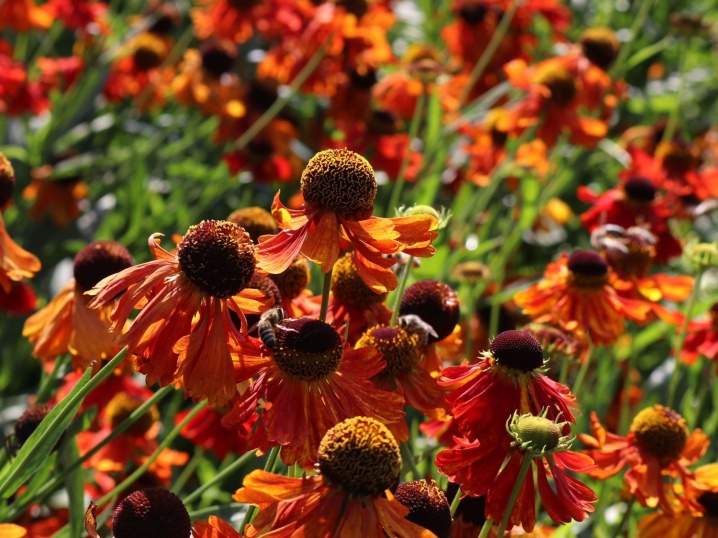
"Granatshtern" - reeds are red, flowers are brown with yellow;

Sommerzonne - variegated variety, rich yellow bloom;

Sonnenberg - juicy yellow variety;

"Katarina" - brown-yellow, pomegranate tongues with orange tint;
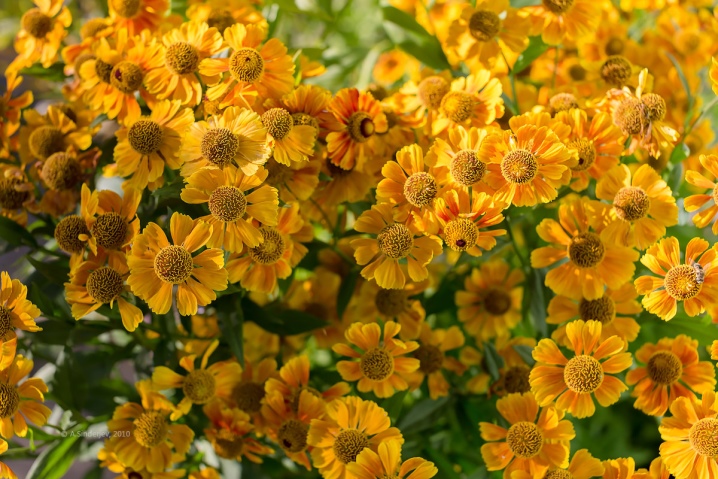
"Cockade" - to the center the petals are red, yellow at the edges;

"Kupffershprudel" - reddish orange with brown tint;

"Lichtgetting" - rich yellow petals;

"Rothhaut" - differs in delicate reddish-brown tongues;
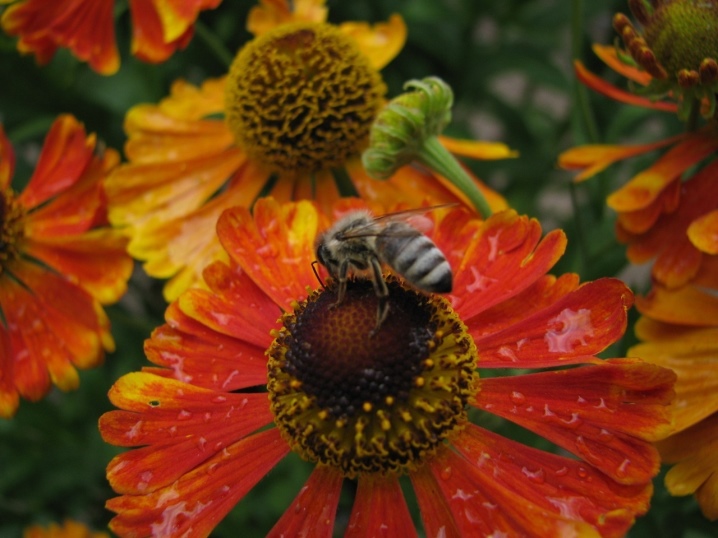
"Rubintswerg" - medium-sized inflorescences of a bright red tone, height 100 cm;

"Autumn Jazz" - height 120 cm, corymbose inflorescences, yellowish-red color;

"Autumn Serenade" - mixed variety with a flowering yellowish-red tone, height 120 cm;

Septemberzonne - yellow-sulfur shade of petals;

Moorheim Beauty - bronze flowers with a red tint;

Chipperfield Orange - variety with bright orange blossoms;

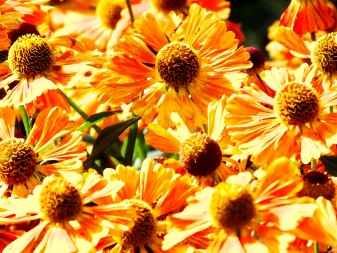
"Spetgoldkuppl" - dark yellow variety;

"Butgrpad" - yellow-golden inflorescences.

Landing rules
Sowing seeds outdoors is usually done in the spring or fall. Can be planted in boxes. For germination, seeds need from 2 to 3 weeks at a temperature of at least 18 C. The culture is transplanted into the soil at the very beginning of summer, with an interval of at least 30 cm. The maximum number of plants per square meter is no more than 5, as the flower grows very actively.
After planting, the soil is mulched. Humus and peat are used for these purposes. Gelenium grows well in the light, as it loves the sun, but it grows well in partial shade. Suitable soil of a fertile type, neutral acidity, well moistened, loosened. To.
The seeds are harvested during the dry season of autumn, before the rainy season, otherwise they will rot. Experts recommend purchasing seed in specialized stores, since the percentage of germination of own material is very low
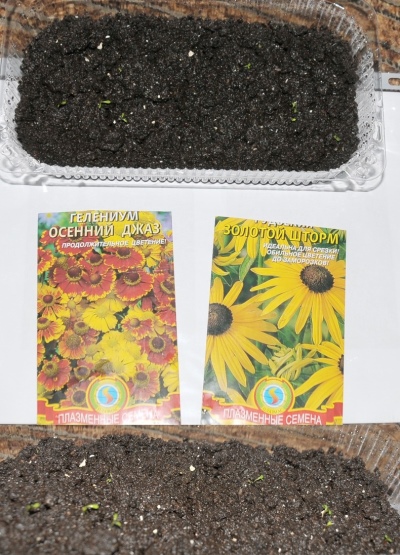
Care features
The plant is undemanding, which is why gardeners love it so much. The only thing that gelenium does not tolerate is the aridity of the soil. If the summer is dry, you should actively water the flower in abundance. It is also necessary to loosen the soil, weed from weeds. To get rid of weeds, you can mulch the soil with peat or leaves. The flower must be prepared for winter:
cut to the soil line;
maximum stem height - 15 cm;
the zone is mulched with moss, sawdust;
on top it is necessary to distribute the non-woven type material.


Top dressing is carried out as follows:
at the beginning of the growing season, the plant is treated with growth stimulants;
in summer, the plant is fed 3 times with mineral and organic fertilizers;
in May, preparations with potassium and organic matter are suitable;
during the flowering period, add complex fertilizers and organic matter;
in October, fertilize with sulfate-potassium, superphosphate formulations.
Pruning helenium is necessary to give the plant splendor. The tops of the shoots are pinched off, the wilted-type inflorescences are removed along with the pieces of the stem. This procedure provokes the activation of branching, abundant flowering.

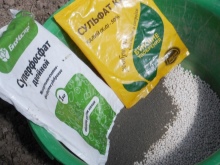

Breeding options
There are several breeding options for helenium, the simplest of which is the division of the bush. Algorithm of actions:
carried out at any time, but May is best;
the bush is dug up, divided into parts;
each cut is cut before planting up to 15 cm;
seated in the chosen place.
Mature plants are best suited for this purpose, varietal characteristics are preserved completely.

Cuttings are also used quite often. Algorithm of actions:
healthy branches are cut in the spring;
placed in water until roots appear;
can be planted in the ground, covered with containers;
they are removed to the shelter after the appearance of the leaves;
such a plant will bloom in a year.

The seed method is not very common, since the germination rate is quite low, and the process is laborious. Helenium is sown in May or in autumn. The soil should be well warmed up. Optimally cover the area with polyethylene. Seedlings are planted in the spring in a container after stratification. After the leaves appear, the plant dives and in May is planted in open ground, after having saturated the root system with moisture.
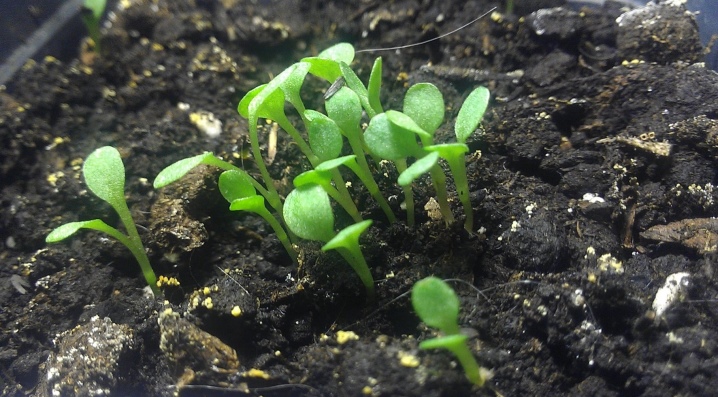
Diseases and pests
This plant has strong immunity, so it almost does not get sick. Very rarely, it is affected by chrysanthemum nematodes, which causes the foliage to dry out. To get rid of the parasites, you need to cut the plants and burn them. The soil is healed with gray or lime. If you provide proper care, prevent moisture stagnation, growing helenium will not bring any particular difficulties.

For transplantation and division of helenium, see below.







































































































The comment was sent successfully.